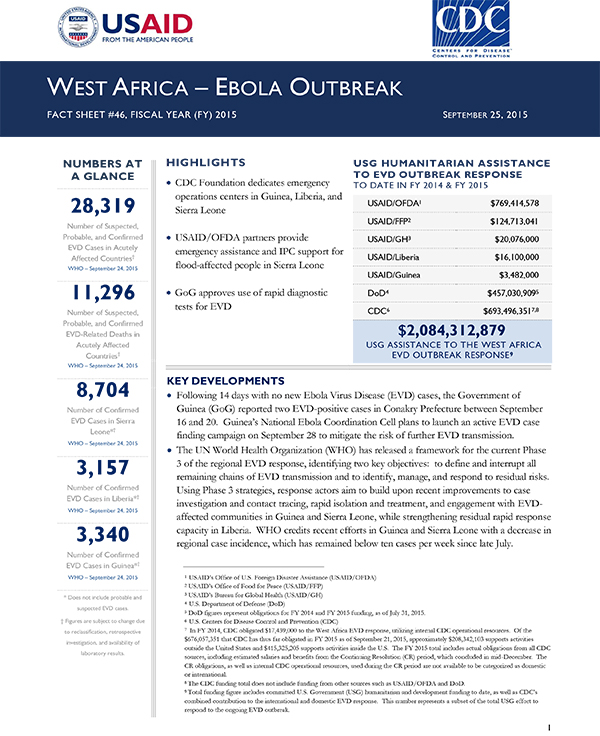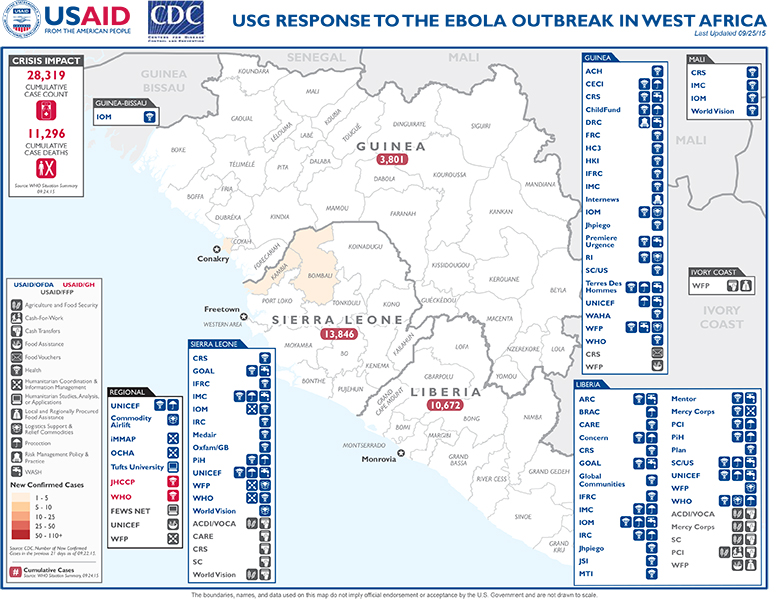Speeches Shim
September 25, 2015
HIGHLIGHTS
Ebola Response
Visit our main West Africa Ebola Outbreak page to learn more about how we're responding to the West Africa Ebola outbreak, and what you can do to help.
- CDC Foundation dedicates emergency operations centers in Guinea, Liberia, and Sierra Leone
- USAID/OFDA partners provide emergency assistance and IPC support for flood-affected people in Sierra Leone
- GoG approves use of rapid diagnostic tests for EVD
KEY DEVELOPMENTS
West Africa Fact Sheet #46 - 09-25-2015 ![]() (pdf - 374k)
(pdf - 374k)
- Following 14 days with no new Ebola Virus Disease (EVD) cases, the Government of Guinea (GoG) reported two EVD-positive cases in Conakry Prefecture between September 16 and 20. Guinea’s National Ebola Coordination Cell plans to launch an active EVD case finding campaign on September 28 to mitigate the risk of further EVD transmission.
- The UN World Health Organization (WHO) has released a framework for the current Phase 3 of the regional EVD response, identifying two key objectives: to define and interrupt all remaining chains of EVD transmission and to identify, manage, and respond to residual risks. Using Phase 3 strategies, response actors aim to build upon recent improvements to case investigation and contact tracing, rapid isolation and treatment, and engagement with EVDaffected communities in Guinea and Sierra Leone, while strengthening residual rapid response capacity in Liberia. WHO credits recent efforts in Guinea and Sierra Leone with a decrease in regional case incidence, which has remained below ten cases per week since late July.
REGIONAL
During the week of September 14–20, WHO reported two new EVD cases in West Africa, both in Guinea. While the cases were epidemiologically linked to a September 1 case in Conakry Prefecture’s Ratoma sub-prefecture, neither was a registered contact. The Ratoma chain of transmission remained Guinea’s only active transmission chain as of September 23, according to WHO.
The number of contacts under observation in the region remains consistent with the two previous weeks; WHO reported approximately 1,300 contacts in Guinea and Sierra Leone as of September 20.
Between September 17 and 23, the CDC Foundation held dedication ceremonies for permanent emergency operations centers (EOCs) in Guinea, Liberia, and Sierra Leone. Each EOC functions as a coordination hub and incident management system to support the respective country’s national-level response to EVD and future publich health emergencies. The ceremonies honored national and regional efforts to end the EVD outbreak and highlighted key contributions from the CDC Foundation and other donors to support the EOCs—including through the development of data management tools for surveillance and contact tracing, as well as the training of EOC staff.
West Africa Map - 09-25-2015 ![]() (pdf - 600k)
(pdf - 600k)
Liberia
As Liberia’s four remaining USAID/OFDA-supported EVD treatment units (ETUs) prepare to close on or around September 30, the USG Disaster Assistance Response Team (DART) and response partners continue working with the Government of Liberia (GoL) Ministry of Health (MoH) and county health teams (CHTs) to ensure adequate isolation, referral, and response capacity among local health facilities. Between September 10 and 18, the DART visited Bong, Grand Cape Mount, and Nimba counties to discuss the upcoming ETU closures with the MoH and response partners. In preparation for the closures of Gbargna and Ganta ETUs in Bong and Nimba, respectively, USAID/OFDA partners International Medical Corps (IMC) and Project Concern International (PCI) have established screening and referral units and temporary triage and isolation units at key health facilities in the two counties. The MoH and other stakeholders agreed that the DoD-constructed, Internal Organization for Migration (IOM)-managed Sinje ETU in Grand Cape Mount will close on September 30, and EVD-related capacities will transfer to the Liberia Government Hospital (LGH) in neighboring Bomi County.
Through USAID/OFDA funding and technical support from WHO, MoH authorities recently completed the second phase of national Integrated Disease Surveillance and Response (IDSR) system trainings, which include community event-based surveillance and sample collection guidance for EVD and other priority diseases. Between September 7 and 12, MoH officials trained clinical supervisors, diagnostic and surveillance officers, and monitoring and evaluation staff from each of Liberia’s 15 CHTs. With technical assistance from the MoH and implementing partners, newly trained CHT personnel are scheduled to conduct the third and final phase of IDSR trainings for district-, facility-, and community-level health staff in the coming weeks. DART, CDC, and WHO staff plan to identify additional technical assistance needs to facilitate the county-level trainings and support local preparedness for surveillance and response operations.
Sierra Leone
The Government of Sierra Leone (GoSL) reported no new confirmed EVD cases from September 14–20, following the confirmation of five new cases between September 7 and 13. Four of the five cases were known high-risk contacts under quarantine in Kambia District; following EVD confirmation, they were transferred to the USAID/OFDA-supported, IMC-managed ETU in Kambia town for treatment. On September 19, the Kambia District Ebola Response Center discharged 830 contacts connected to the cluster from quarantine; 14 remaining high-risk contacts are scheduled to be discharged by September 29.
The additional EVD case, a 16-year old girl, marked Bombali District’s first case in 170 days. On September 12, health care workers at a local health unit in Bombali successfully screened, isolated, and transported the girl to Makeni ETU according to infection prevention and control (IPC) protocol; she subsequently died of EVD on September 13. USAID/OFDA partner GOAL provided IPC training and supervision at the local health unit as part of a program supporting IPC activites at 104 health units in Bombali; a recent field assessment by CDC and WHO reported strong adherence to IPC protocol among the units.
USAID/OFDA recently provided the International Rescue Committee (IRC) with approximately $5.4 million to continue IPC activities in Sierra Leone. The IRC-led Emergency Response Consortium—which includes IRC, GOAL, and other USAID/OFDA partners—conducts IPC training and mentoring in more than 1,100 health units in Sierra Leone, as well as 19 of the country’s 22 governmental hospitals.
On September 19, a WHO-led ring vaccination team began administering the EVD vaccine to primary and secondary contacts of the Bombali case. The 781 people—including 23 high-risk contacts—currently under quarantine in Bombali are scheduled to be discharged by October 4.
On September 16, heavy rainfall generated flooding that caused at least eight deaths and affected an estimated 14,000 people in Sierra Leone’s capital city of Freetown, according to the UN Office for the Coordination of Humanitarian Affairs (OCHA). Humanitarian organizations—including USAID/OFDA partners the International Organization for Migration and GOAL—supported the GoSL in providing emergency assistance, including water, sanitation, and hygiene support, to flood-affected people. The Western Area Ebola Response Center (WAERC) reports that many of the displaced people sheltering at two Freetown stadiums came from the city’s high-risk wharf communities, providing a unique opportunity to conduct EVD surveillance and monitoring of otherwise hard-to-reach populations. The WAERC established robust health screening at stadium entrances, and EVD response actors provided IPC support to medical personnel treating flood-affected people.
Guinea
Between September 14 and 20, the GoG reported two EVD-positive cases in Conakry Prefecture, including one in Ratoma sub-prefecture identified by post-mortem swab on September 16 and one in Dixinn sub-prefecture confirmed on September 19. Guinea’s National Ebola Coordination Cell plans to launch an active EVD case finding campaign in Dixinn and Ratoma on September 28 to mitigate the risk of further EVD transmission. The campaign will include doorto-door household and health clinic visits; community mobilization and hygiene promotion activities; and efforts to vaccinate all primary and secondary contacts of the recent EVD cases.
Conakry is currently Guinea’s only prefecture with active EVD transmission. However, Forécariah Prefecture remains on alert due to the identification of more than 300 contacts related to the September 16 case in Ratoma. As of September 20, EVD response actors were monitoring more than 500 contacts countrywide.
In coordination with the GoG and USAID/OFDA partners, the DART is working to improve EVD detection and response capacity at private and small-scale clinics throughout Conakry. The GoG and WHO report that Guinea’s two recent cases sought treatment at private health care facilities in Conakry, with the September 16 case generating nearly 70 new contacts at a clinic in Ratoma sub-prefecture before its closure due to breach of IPC protocols. In response to the need for improved IPC measures, USAID/OFDA is supporting Catholic Relief Services (CRS) to conduct IPC training, supervision, and quality assurance activities at more than 40 private and small-scale health care clinics in Conakry.
The GoG recently approved the use of rapid diagnostic tests (RDTs) for EVD. Staff from CDC, the GoG, WHO, and other response partners are scheduled to begin training 150 Red Cross safe burial team members and sub-prefectural and health center staff on RDT use in Forécariah on September 16. There are currently 750 EVD RDTs in Guinea, with an additional 5,000 expected to arrive in the coming days. CDC reports that the newly trained personnel will initially utilize the RDTs to test febrile patients, other suspected EVD cases, and all new deaths in Forécariah. Following the EVD RDT pilot in the prefecture, the GoG may expand RDT use for burial teams and health care staff in Conakry. CDC reports that the RDTs currently require follow-up testing at laboratories.
PUBLIC DONATION INFORMATION
- The most effective way people can assist relief efforts is by making cash contributions to humanitarian organizations that are conducting relief operations. A list of humanitarian organizations that are accepting cash donations for disaster responses around the world can be found at www.interaction.org.
- USAID encourages cash donations because they allow aid professionals to procure the exact items needed (often in the affected region); reduce the burden on scarce resources (such as transportation routes, staff time, and warehouse space); can be transferred very quickly and without transportation costs; support the economy of the disaster-stricken region; and ensure culturally, dietary, and environmentally appropriate assistance.
More information can be found at:
- The Center for International Disaster Information: www.cidi.org or +1.202.821.1999.
- Information on relief activities of the humanitarian community can be found at www.reliefweb.int.
USAID/OFDA bulletins appear on the USAID website at what-we-



Comment
Make a general inquiry or suggest an improvement.